Introduction
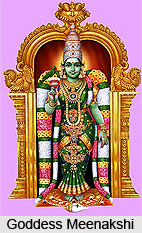 Madurai district is located in the southern part of the state of Tamil Nadu. It is bounded on the North by the districts of Dindigul, Thiruchirapalli and to the east by Sivagangai and to the west by Theni and to the south by Virudhunagar. The total area covered by this district is 3741.73 square kilometres. The district of Madurai is surrounded by several mountains. This district also has three hills as its boundaries as Yanaimalai, Nagamalai, Pasumalai named after Elephant, Snake and Cow respectively. The district is famous for Jasmine flowers. Jasmine flowers from the district of Madurai are transported to other cities of India. There are several temples in this district which attract people from different parts of the state and various other parts of India.
Madurai district is located in the southern part of the state of Tamil Nadu. It is bounded on the North by the districts of Dindigul, Thiruchirapalli and to the east by Sivagangai and to the west by Theni and to the south by Virudhunagar. The total area covered by this district is 3741.73 square kilometres. The district of Madurai is surrounded by several mountains. This district also has three hills as its boundaries as Yanaimalai, Nagamalai, Pasumalai named after Elephant, Snake and Cow respectively. The district is famous for Jasmine flowers. Jasmine flowers from the district of Madurai are transported to other cities of India. There are several temples in this district which attract people from different parts of the state and various other parts of India.
History of Madurai District
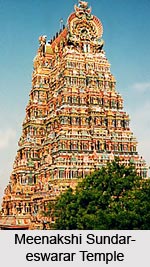 History of Madurai district connects it to an interesting legend by which the district got its name. As per the legend, the place was originally a forest called Kadambavanam. Once, a farmer called Dhananjaya noticed Lord Indra worshipping the swayambhu or the self-created Lingam under a Kadamba tree, while he was passing through the forest. He informed the incident to the King Kulasekara Pandya. Then the King cleared the forest and constructed a temple around the Lingam and settlements were also planned around the temple. On the very day of naming the place, Lord Shiva is said to have presented himself there and drops of nectar from his hair fell on that place. Thus the name of the place became Madurai, which means sweetness in Tamil.
History of Madurai district connects it to an interesting legend by which the district got its name. As per the legend, the place was originally a forest called Kadambavanam. Once, a farmer called Dhananjaya noticed Lord Indra worshipping the swayambhu or the self-created Lingam under a Kadamba tree, while he was passing through the forest. He informed the incident to the King Kulasekara Pandya. Then the King cleared the forest and constructed a temple around the Lingam and settlements were also planned around the temple. On the very day of naming the place, Lord Shiva is said to have presented himself there and drops of nectar from his hair fell on that place. Thus the name of the place became Madurai, which means sweetness in Tamil.
Madurai has a rich historical background in the sense that Lord Shiva himself performed sixty four wonders called `Thiruvilaiyadals`. As early as the third century BC, Megasthanes visited Madurai. Later, several people from Rome and Greece visited the district of Madurai and set up trade links with the kings of the Pandya dynasty. The district of Madurai flourished till the tenth century AD when it was captured by Cholas, the arch rivals of the Pandyas. The Cholas ruled over Madurai from AD 920 till the beginning of the thirteenth century. In AD 1223, the Pandyas regained their kingdom and once again became prosperous. The Pandian Kings patronized Tamil language in a great way and in their period many master-pieces were created. `Shilapaddikaram`, the great epic in Tamil was written based on the story of Kannagi who burnt Madurai as a result of the injustice caused to her husband Kovalan. In the month of April 1311, Malik Kafur, the general of Ala-ud-din Khilji, the then ruler of Delhi, reached Madurai and raided and robbed the city for precious stones, jewels, and other rare treasures. This led to the subsequent raids by other Muslim Sultans. In 1323, the Pandya kingdom including Madurai became a province of the Delhi Empire under the Tughlaks.
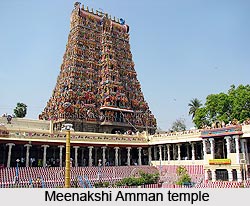 The Vijayanagar dynasty of Hampi captured Madurai in 1371 and the district became a part of the Vijayanagar Empire. Kings of this dynasty used to leave the captured land to governors called Nayaks. This was done for the efficient management of their empire. The Nayaks paid fixed amount annually to the Vijayanagar Empire. After the death of Krishna Deva Raya, the King of Vijayanagar Empire, in AD 1530, the Nayaks became independent and ruled the territories under their control. Among Nayaks, Thirumalai Nayak was very popular; even now he is popular among people, since he contributed to the creation of several magnificent structures in and around Madurai. The Raja Gopuram of the Meenakshi Amman temple, the Pudu Mandapam and the Thirumalai Nayakar`s Palace are living monuments to his artistic fervour.
The Vijayanagar dynasty of Hampi captured Madurai in 1371 and the district became a part of the Vijayanagar Empire. Kings of this dynasty used to leave the captured land to governors called Nayaks. This was done for the efficient management of their empire. The Nayaks paid fixed amount annually to the Vijayanagar Empire. After the death of Krishna Deva Raya, the King of Vijayanagar Empire, in AD 1530, the Nayaks became independent and ruled the territories under their control. Among Nayaks, Thirumalai Nayak was very popular; even now he is popular among people, since he contributed to the creation of several magnificent structures in and around Madurai. The Raja Gopuram of the Meenakshi Amman temple, the Pudu Mandapam and the Thirumalai Nayakar`s Palace are living monuments to his artistic fervour.
The district of Madurai started to slip into the hands of the British East India Company. In the year 1781, British appointed their representatives to look after Madurai. George Procter was the first collector of Madurai. After the Indian independence, Madurai became one of the most prominent districts of the state of Tamil Nadu in India. In the year 1985, the vast Madurai district was bifurcated into two districts called Madurai and Dindigul district. Subsequently in the year 1997, Madurai district was again bifurcated into two districts called Madurai and Theni district. In Madurai district, there are ten state assembly constituencies and two parliamentary constituencies.
Geography of Madurai District
The Madurai district is having its border as the Dindigul district to the North, to the East is the Tiruchirapalli district, to the East by Sivagangai, to the West by Theni and to the South by Virudhunagar. Madurai is surrounded by several mountains. This district lies between nine degree thirty minutes and ten degree thirty minutes to the North latitudes and between seventy seven degree and seventy eight degree thirty minutes to the East latitudes.
Festivals in Madurai District
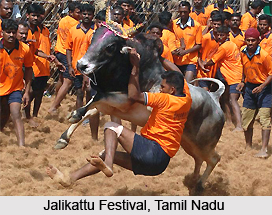 Festivals in Madurai district are celebrated very grandly with lots of enthusiasm throughout the year and reflect the regional traditions and customs of this part of the country. Some of the most prominent festivals in the district of Madurai in Tamil Nadu state are `Pongal`, `Jallikattu`, `Chithirai Thiruvizha`, `Festival of the Cradle`, `Navaratri`, `Avanimoolam`, `Dance Festival` and much more. Among these festivals, Pongal is the well-known festival of this district which is celebrated for a period of three days. The Dance Festival is however organized by the department of tourism where dancers all corners of Tamil Nadu as well as from different parts of the country take part. This is celebrated for a period of fifteen days.
Festivals in Madurai district are celebrated very grandly with lots of enthusiasm throughout the year and reflect the regional traditions and customs of this part of the country. Some of the most prominent festivals in the district of Madurai in Tamil Nadu state are `Pongal`, `Jallikattu`, `Chithirai Thiruvizha`, `Festival of the Cradle`, `Navaratri`, `Avanimoolam`, `Dance Festival` and much more. Among these festivals, Pongal is the well-known festival of this district which is celebrated for a period of three days. The Dance Festival is however organized by the department of tourism where dancers all corners of Tamil Nadu as well as from different parts of the country take part. This is celebrated for a period of fifteen days.
Pongal
Pongal is the most popular festival celebrated in the Madurai district and is also known as the `harvest festival`. This festival is celebrated in order to pay tribute to the Sun God, Mother Nature and cattle for helping the people to get a rich harvest. The three day long festival is held with lots of pomp and glory. On the first day of Pongal, `Bhogi` is celebrated. Houses of the people of this district are given a fresh coat of paint and old articles are replaced by new ones. The second day of Pongal is the main festival. Sugarcanes, festoons of mango leaf and Pongal (a sweet variety of rice) mark this auspicious day. On the third day of Pongal, `Mattu Pongal` is celebrated and on this very day people pay tribute to the cattle for bringing in prosperity.
Jallikattu
Jallikattu or the festival of taming the Bull is one of the most popular sports in the district of Madurai and it also forms a part of the Pongal celebration. This game of valour is held in the villages with lots of enthusiasm though only as a popular sport. People from neighbouring villages throng the open grounds to watch man and beast confronting each other with all their strength. It is observed in the month of January and is an important historical festive event.
Chithirai Thiruvizha
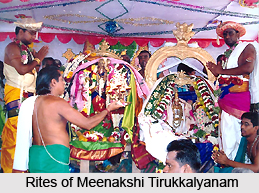 Another well-known festival in the district of Madurai is the Chithirai Thiruvizha. This festival is celebrated every year on the full moon day of the Tamil month Chithirai with is from April to May. As per local legend, Lord Vishnu, as `Alagar`, rode over a golden horse to Madurai to attend the celestial wedding of Lord Sundareswarar or Lord Shiva with Goddess Meenakshi. The celebration of this festival is marked with serenity and solemnity. The Festival of the Cradle is a celebration when the deities of Goddess Meenakshi and Lord Sundareswarar are taken in procession to a mirror chamber. The Gods and Goddesses are placed on a nine day swing, which rocks gently. It is also known as the Meenakshi Tirukkalyanam.
Another well-known festival in the district of Madurai is the Chithirai Thiruvizha. This festival is celebrated every year on the full moon day of the Tamil month Chithirai with is from April to May. As per local legend, Lord Vishnu, as `Alagar`, rode over a golden horse to Madurai to attend the celestial wedding of Lord Sundareswarar or Lord Shiva with Goddess Meenakshi. The celebration of this festival is marked with serenity and solemnity. The Festival of the Cradle is a celebration when the deities of Goddess Meenakshi and Lord Sundareswarar are taken in procession to a mirror chamber. The Gods and Goddesses are placed on a nine day swing, which rocks gently. It is also known as the Meenakshi Tirukkalyanam.
Avanimoolam
Avanimoolam is another festival celebrated in the Madurai district of Tamil Nadu. It is organised during the month of September, when the coronation of Lord Sundareswarar or Lord Shiva takes place. A `Lila` or play is also performed where the temple priest narrates the stories of Lord Shiva in sixty four miracles, which protected Madurai from adversity.
Thepporchavam
Also referred to as the `Float Festival`, `Thepporchavam` is observed in `Thai`, a Tamil month which constitutes the period around January to February. It is celebrated to honour the king Thirumalai Nayak`s birth anniversary. During this festival, the idols of Goddess Meenakshi and Her consort Sundareshwarar or Lord Shiva are beautifully decorated and marched in a procession till Mariamman Teppakulam from the Meenakshi Temple.
Santhanakoodu
Santhanakoodu festivals are often observed in Madurai city on different days, as per the Islamic calendar year. Various Islamic saints are honoured and remembered with great respect in Santhanakoodu festivals.
Navaratri or nine nights is one of the festivals held in honour of Goddess Meenakshi in all her forms, which embody fury, compassion and wisdom, in the district of Madurai. In these nine days, Goddess Meenakshi is offered nine varieties of rice meals and nine varieties of flowers. Apart from these there are various other festivals celebrated in this district. The Dance Festival celebrated in the Madurai district is of great importance. The department of tourism organizes this festival where exponents of several dance forms from different parts of the country take part in this festival.
Temples around Madurai
Temples around the town of Madurai are as follows
Coodal Azhagar Temple: To the west of Madurai temple is this ancient Vishnu shrine with beautiful sculptures. The Lord is seen in sitting, standing and reclining postures, each depicted one above the other in a three-tier form.
Azhagarcoil: It is located 20 kilometers away from Madurai. The Vishnu temple here is dedicated to Sundararajar or Kallazhagar. It is situated in the picturesque surroundings at the foot of Azhagar Hills. The presiding deity is also known as Paramaswamy. `Abhishekam` or the coronation of the Lord is performed only with water brought from Noopura Ganga, a sacred Teertha on the hills, since any other water, if used, will discolor the idol. The deities of Kalyana Sundaravalli Nachiyar, Andal, Sudarshana and Yoga Narasimha are in separate shrines.
Lord Karuppanna Swamy, guardian deity of the shrine and Goddess Rakhayi Ammai deserve special mention. A flight of 18 steps leads one to the main entrance to the Karuppanna Swamy shrine. Pujas are performed for these steps and the big wooden door.
The major festival takes place on Chitra Poornima day. Azhagar, the brother of Meenakshi, is taken in a procession to river Vaigai to participate in the Meenakshi-Sundareswarar wedding.
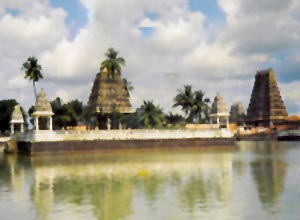 Pazhamudircholai: This is one of the six abodes (Arupadai Veedu) of Lord Subramanya. It is situated around 2 kilometers from Azhagarcoil on the hills.
Pazhamudircholai: This is one of the six abodes (Arupadai Veedu) of Lord Subramanya. It is situated around 2 kilometers from Azhagarcoil on the hills.
Thiruparankundram: Located 8 km away from Madurai this 6th century rock-cut temple is dedicated to Lord Subramanya. It is one of the six abodes (Arupadai Veedu) of the Lord. Here, Subramanya married Deivayanai, daughter of Indra, after the victory over Surapadman.
The main shrine is an early cave temple situated at a height of 1050 feet. There are 48 artistic pillars at the entrance of this shrine.
A seven-tier gopuram above the Kalyana Mandapam is a great piece of sculpture. In the sanctum, there are 5 cells, each enshrining a deity. In the central shrines Muruga, Durga and Vinayaka are worshipped.
A special feature of Vinayaka is that He is holding only fruits and sugarcane. Muruga is in sitting posture with Deivayanai. To Her right is sage Narada. Vinayaka. Brahma, Indra, Surya and Chandra are depicted above these images. In the two cells facing each other, there are images of Vishnu with Sridevi and Bhoodevi and a Lingam respectively.
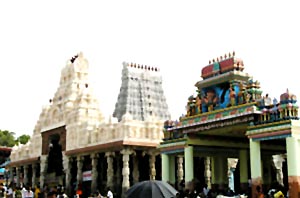 At the top of the hill, there is a shrine dedicated to Kasi Viswanatha. The image of Nakkeerar, the Tamil poet, is seen here standing in reverence.
At the top of the hill, there is a shrine dedicated to Kasi Viswanatha. The image of Nakkeerar, the Tamil poet, is seen here standing in reverence.
Thirumohur: Here is a Vishnu temple dedicated to Kaalamegha Perumal. In the shrine of Chakrathalwar, the deity is installed on a Peeta with Bhijakshara Mantra. This place is considered as holy as Naimisaranyam in North India. From Madurai the tourists need to travel 11 kilometers to reach this pilgrimage site.
Manamadurai: It is closely associated with Ramayana. Hanuman is said to have stopped over here with his brigade on his way to Lanka to rescue Sita from Ravana. In the Vishnu temple here, Hanuman is seen in an unusual form wearing a crown on his head. Legend has it that Hanuman was crowned here before he set out for Lanka. From Madurai it is 120 kms away.
Kalaiyarcoil: The Siva temple, 64 km from Madurai, is dedicated to Kaliswarar and His consort Swarnavalli. Following Lord Shiva`s curse, Goddess Parvati came here in the form of Kali to do penance. She annihilated Chandasura and regained Her original form. Shiva later married Her. There are also shrines for Komeswarar and Sundaresar.
Thiruvaadaanai (37 km from Devakottai): The red stone Vinayaka here was worshipped by Sri Rama during His banishment. Adi Sankara is said to have sung in praise of this Vinayaka in his Ganesha Pancha Ratna Mala.
According to a legend, sage Durvasa cursed Varuni, son of Varuna, to be metamorphosed into the body of an elephant with the head of a goat. Varuni did penance at the Adi Ratneswara temple here and regained his original form. Thus the origin of the name Thiruvaadaanai is related to this legend as `Thiru` means sacred; `Aadu` - goat and `Aanai` stands for an elephant.
Pillayarpatti: This village is located at a distance of 11 km from Karaikudi. This place derives its name from the image of Lord Ganesha, known as Karpaga Vinayaka. The image is carved on the wall of an ancient rock-cut temple.
 The Lord is seated and appears with only two arms. His left arm is on the waist and in the right hand He is holding a modaka. The trunk is turned to the right. There is no sacred thread on this Ganesha sculpture.
The Lord is seated and appears with only two arms. His left arm is on the waist and in the right hand He is holding a modaka. The trunk is turned to the right. There is no sacred thread on this Ganesha sculpture.
A few kilometers from here is Kundrakudi. This place is known for the temple of Muruga.
Thirukoshtiyur (10 km from Tirupattur): This is the birthplace of Nambi Andar, Guru of Sri Ramanuja. In the Vishnu temple the Lord is worshipped in four different postures in a four-tier structure.
Avudayarcoil: Located 180 km from Madurai and 15 km from Arantangi this place is known for Sri Atmanandaswamy temple. It is known for its exquisite sculptural work.
There is no Lingam in the sanctum. It contains only the base of the Lingam. Similarly, only a Sri Vidya Chakra represents the Goddess. It is said that the Lord gave darshan to Manickavasagar below the Kurunthai tree, the Sthala Vriksham.
The temple has numerous halls such as Panchakshara Mandapam, Natana Sabha and Deva Sabha. Each of these symbolise a different philosophy involving the worship of Shiva. The sanctum also has five Deepas representing five Kalas and 27 Deepas representing the 27 Nakshatras.
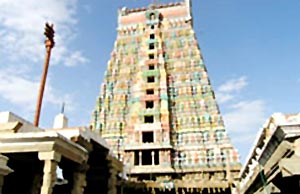 Srivilliputhur: This is the birthplace of Sri Andal, the Divine Child brought up by Vishnu Chittar (Periya Alwar). The girl, by her insatiable love for and true devotion to Lord Ranganatha, decided that she would marry only the Lord. At the bidding of Lord Ranganatha, Andal was taken to Srirangam in a palanquin in bridal pomp and glory. She was led into the sanctum, where she merged with the Lord. It is 80 km away from Madurai.
Srivilliputhur: This is the birthplace of Sri Andal, the Divine Child brought up by Vishnu Chittar (Periya Alwar). The girl, by her insatiable love for and true devotion to Lord Ranganatha, decided that she would marry only the Lord. At the bidding of Lord Ranganatha, Andal was taken to Srirangam in a palanquin in bridal pomp and glory. She was led into the sanctum, where she merged with the Lord. It is 80 km away from Madurai.
Hence the main attraction at Srivilliputhur is the shrine of Lord Ranganatha and Andal where their images are installed in bridal attire. Garuda Alwar is enshrined by the side of Sri Ranganatha.
Andal`s devotional Tamil songs, known as Thiruppavai, are as popular as Meera`s bhajans.
The shrines of Vatapatrasayee (Vishnu reclining on Adi Sesha), Navaneeta Krishna and Srinivasa Perumal in Srivilliputhur are noteworthy too.
The fifth day of Adi festival (July-Aug) and the sixth day of Margazhi festival (Dec-Jan) here attract thousands of pilgrims.
Kuchanoor: The temple here is dedicated to Saniswara, who is a Swayambu image. It is located near Theni. People throng this place on Saturdays. The annual festival in Adi and Shani Peyarchi attract lots of pilgrims.
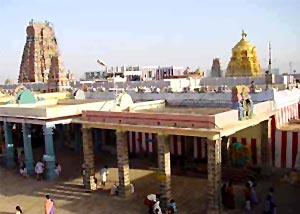 Palani: This hill temple, 125 kilometers from Madurai, is one of the six abodes (Arupadai Veedu) of Lord Muruga. In the sanctum, the Lord stands as an young ascetic holding a dhanda. Hence He is known as Bala Dhandayudhapani.
Palani: This hill temple, 125 kilometers from Madurai, is one of the six abodes (Arupadai Veedu) of Lord Muruga. In the sanctum, the Lord stands as an young ascetic holding a dhanda. Hence He is known as Bala Dhandayudhapani.
According to a legend, Muruga lost in a contest with His brother Vinayaka over a rare mango. He left Kailash in a huff and came down to this hill. Here, Lord Shiva pacified Him by saying that He Himself is the embodiment of Gyana (Knowledge). The Lord from then on came to be known as Palani Murugan or Palani Andavar.
There is another legend associated with Palani. The hills named Shaktigiri and Sivagiri were once carried on the shoulders by Idumban, the disciple of sage Agastya, at the Rishi`s bidding for his worship. On his way Idumban placed the hills here to take rest. But when he wanted to carry them again he could not lift them. To his surprise, Idumban noticed Muruga standing there, claiming Sivagiri to be His. This led to a clash between the two. Agastya intervened, pacified Muruga and worshipped the Lord there. Muruga blessed Idumban and gave him a permanent place in Shaktigiri. The popular Kavadi worship in this temple is in commemoration of this legend.
The deity of Muruga is said to have been created by Bhoga Siddhar, an ardent devotee, by using Navapashanam (an amalgam of nine poisonous minerals). The continuous process of `abhisheka` and `alankara` are noteworthy in the temple. The `abhishekaprasada` is said to have curative properties.
The festivals held at this temple include Thai Poosam held during January-Februaury, Panguni Uthiram (April-May) and Skanda Shashti (Nov-Dec) besides Karthigai and Shashti every month.
Tourism in Madurai District
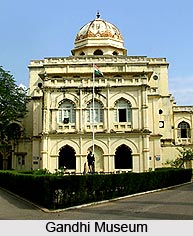 Tourism in Madurai district offers beautiful temples and palaces which speak of its rich past. There are several temples in this district which attract a large number of tourists from all parts of the state of Tamil Nadu and various other parts of India. The Gandhi Museum present in this district displays some of the best images of the Indian independence struggle in its picture gallery. Another attraction of this district in the Tamil Nadu state is the Mariamman Teppakulam. It is a very beautiful tank located close to the Meenakshi Temple. This is the site for the celebration of the famous float festival.
Tourism in Madurai district offers beautiful temples and palaces which speak of its rich past. There are several temples in this district which attract a large number of tourists from all parts of the state of Tamil Nadu and various other parts of India. The Gandhi Museum present in this district displays some of the best images of the Indian independence struggle in its picture gallery. Another attraction of this district in the Tamil Nadu state is the Mariamman Teppakulam. It is a very beautiful tank located close to the Meenakshi Temple. This is the site for the celebration of the famous float festival.
One of the most prominent tourist attraction as well as a religious place is the Meenakshi Sundareswarar twin temple. It is centrally located in the Madurai district. The complex of the Meenakshi temple is one of the largest and the oldest of its kind in India. The temple developed by suitable contribution of each dynasty and victorious monarchs which ruled over the district of Madurai, into an enormous complex covering an area of more that sixty five thousand square meters. The famous temple first came in to being about two thousand years ago and was expanded under the rule of Thirumalai Nayak from A.D. 1623 to A.D. 1655. Lord Shiva in his incarnation as Sundareswarar and Meenakshi, his fish-eyed spouse, are enshrined in this twin temple. There are four huge gateways enfolding these two shrines. One of the most striking features of this temple is the astonishing structure called `Ayiramkaal Mandapam` or the Hall of Thousand Pillars and each pillar features high, ornate, bold life like sculptures. These pillars look to be in a straight line even if viewed from any angle. In the outermost corridors are located the matchless musical pillars carved out of stones. When tapped, each pillar generates a different musical note.
Another temple of importance in this district of Tamil Nadu state is the Thirupparankundram temple. The innermost shrine of this temple is carved out of a solid rock. It is situated at a distance of about eight kilometers to the south of Madurai Railway Junction. It is one of the six abodes of Lord Subramanya. Alagar koil is at a distance of twenty one kilometers to the North-east of Madurai. This is a celebrated Vishnu temple devoted to Lord Alagar. It is located on a hill amidst a panoramic surrounding. This shrine is known as Alagarkoil and the hill on which it is situated is Solaimalai. This Vishnu temple also possesses some of the most beautiful carvings.
Thirumalai Nayakkar Mahal is situated at a distance of fifteen hundred meters from the Meenakshi temple. The palace was erected in the year 1636 by the ruler Thirumalai Nayak. The impressive edifice is famous for the Stucco work on its domes and arches. The Sorgavilasam or the celestial pavilion has been made entirely of brick and mortar without the help of a single rafter or girder. It is a marvel of Indo-Saracenic architecture in India. 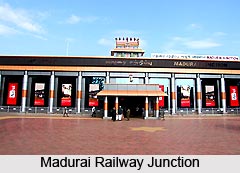 The palace contains massive white pillars, several of which line the corridor that runs along the courtyard. Linked by high decorated arches, these pillars measure twenty meters in height and have a circumference of four meters. There are also polished black stone pillars of varying heights in this palace. It was the grandson of King Thirumalai Nayak who destroyed much of the fine structure and removed most of the jewels and woodcarvings in order to construct his own palace in Tiruchirapalli.
The palace contains massive white pillars, several of which line the corridor that runs along the courtyard. Linked by high decorated arches, these pillars measure twenty meters in height and have a circumference of four meters. There are also polished black stone pillars of varying heights in this palace. It was the grandson of King Thirumalai Nayak who destroyed much of the fine structure and removed most of the jewels and woodcarvings in order to construct his own palace in Tiruchirapalli.
Lord Napier, the then Governor of Chennai (Madras), partially restored the palace in 1866-1872, and the subsequent restoration works which were carried out several years ago helped to restore the Entrance Gate, the Main Hall and the Dance Hall as they are today. Another place of tourist interest in this district is the Gandhi Museum which is housed in the old Palace of Rani Mangammal. This museum depicts the highlights of the freedom struggle and displays a picture gallery of the Gandhian movement. There is also a gallery of relics, South Indian Handicrafts section and Khadi and village industries section in the Gandhi Museum.
A beautiful square tank known as the Mariamman Teppakulam spreads over an area of sixteen acres. It is situated at a distance of about five kilometers from the Meenakshi temple. The tank is the site for the celebration of the colourful float festival which is held in the month of January-February to celebrate the birth anniversary of King Thirumalai Nayak, the founder of this tank. The deities of Meenakshi and Sundareswarar are placed in a float, known as `Teppam` and decorated with flowers and illuminated with hundred of lights. This is a very grand celebration and people in large numbers gather to enjoy the occasion. To the north of this tank is a temple devoted to a renowned village deity of Tamil Nadu known as Mariamman.
Visiting Places around Madurai
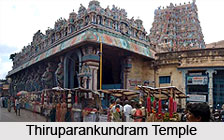 The visitors can roam around various beautiful places surrounding Madurai. Some of these places are given here:
The visitors can roam around various beautiful places surrounding Madurai. Some of these places are given here:
Thiruparankundram
Thiruparankundram is one of the abodes of Lord Subramanya. It is situated 8 kms south of Madurai. The six abodes of the deity are known as `Arupadai Veedu`. This is a cave temple. This temple is known from the Sangam times. One of the Sangam poets Nakkiran has sung a long poem about this temple called Thirumurugatrupadai.
In this temple of Thiruparankundram, there are a series of mandapams one above the other in elevation. A shrine dedicated to Nakkirar can be seen here. The marriage of Deivayanai and the sculptures of Thirumalai Nayak and Mangammal can be seen in the front mandapam.
There are caves in the descent from the mandapam. These are filled with images of Annapoorna, Varaha Avataram, Narasimha Avataram, Mahalakshmi etc. One of the masterpiece sculptures of the group is the Sivathandavam in which Uma is witnessing it reclining on the bull. The Kudarmugha drum also can be seen being beaten by a celestial attendant.
Kallazhagar Koil
Kallazhagar Koil is situated 21 kms from Madurai. It is an important Vishnu temple at the foot of a wooded hill. The term `Azhagu` in Tamil means beauty and true to its meaning, everything here is a thing of beauty and a joy forever.
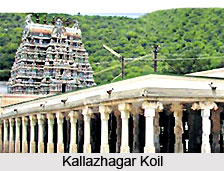 In this Kallazhagar Koil, the main deity is Paramaswami and the itinerant idol is Kallazhagar. This beautiful idol is made of pure gold. Apart from this and another at Thiruvanathapuram, no other temple has an idol made of pure gold. The ablution water for this idol is brought from Noobura Gangai, which is a perennial waterfall 3 kms up on the hill. Its water contains copper and iron minerals.
In this Kallazhagar Koil, the main deity is Paramaswami and the itinerant idol is Kallazhagar. This beautiful idol is made of pure gold. Apart from this and another at Thiruvanathapuram, no other temple has an idol made of pure gold. The ablution water for this idol is brought from Noobura Gangai, which is a perennial waterfall 3 kms up on the hill. Its water contains copper and iron minerals.
The Vimanam of this temple is known as the `Somaskanda Vimanam` i, e, tower over the sanctum and it is a unique one of its kind. The Kalyana Mandapam of Kallazhagar Koil contains sculptures that rival the one at Madurai. The images of Krishna, Rathi, Manmatha, Garuda Vahana, Trivikrama, Lakshmi and Varaha Avatar are genuine masterpieces in stone. The British wanted to shift the temple to one of the museums in England, but anyhow the attempt was failed.
Pazhamudir Solai
It is situated about 4 kms above on the hill. It is beautifully located amidst sylvan surroundings. This temple can be climbed through thickly shaded woods through which the rays of sun rarely peep in. There are several perennial springs on the way. It is said to be one of the 6 abodes of Lord Muruga. Here, Lord Muruga stands with His `Vel` (spear) in the hand. The ruins of a fort built by Thirumalai Nayak can also be found here.
Thiruvedagam
It is situated about 15 kms north-west of Madurai on the left bank of the river Vaigai. This is the place where Saivite supremacy over the Jains was established by performing Punal Vadam i.e. each contestant would put into the stream sacred palm leaves. Sacred hymns are written on them and if the palm leaves do not sink or get carried by the running stream but sail upstream the one who set it sail is the winner. The palm leaves of the Jains were carried away by the stream and the palm leaves of Gnanasambandar sailed upstream. In this way, the Saivite supremacy over the Jains was proved.
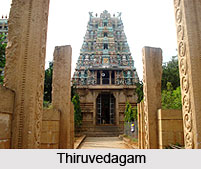 Thiruvadhavur
Thiruvadhavur
This place is situated about 9 kms from Melur near Madurai. This is the birthplace of one of the Saivaite saint Manickavasagar. He was the minister to a Pandya king. It is said that he built a temple for Siva with the money he was entrusted to buy horses for the king. Later, Lord Siva performed a miracle by which foxes were transformed into horses. These were taken by the king and sent to the stables, where they again turned into foxes. The site of the house of his birth is pointed out to visitors.
Madappuram Badrakali Amman Temple
Madappuram Badrakali Amman Temple is a famous temple of Tamil Nadu. It is situated at Madappuram about 20 kms from Madurai near Thiruppuvanam. Many V.I.Ps, cine stars and I.A.S. officers often visit this temple. It stands on the banks of the river Vaigai on the northern side of Esanar Koil.
This Badrakali Amman Temple is situated amidst a cool coconut grove. The first idols that greet the visitor here are that of Lord Ayyanar and of his horse. The idol of the horse has protruding teeth and bulging eyes and Lord Ayyanar is shown with a fierce look. These two together really make the visitors tremble in fright. The height of the horse is 30 ft, which wears a garland of lemons.
A large number of devotees pray to the Goddess, the presiding deity of this temple, for creative comforts, promotions in job and for the ruin of their enemies. There is a peculiar practice in this Badrakali Amman temple as per which a coin is cut and it is offered to the deity to get relief from being bullied by the mighty. A gunny bag full of cut coins is therefore seen here.
Vaigai Dam
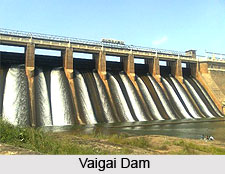 This dam is situated across the river Vaigai is 69 kms from Madurai. This was constructed to enhance the water supply. The height of this dam is 106 ft and its breadth is 11,657 ft. Its capacity is 58,000 cubic ft. It irrigates several hectares of land. A beautifully decorated garden can be seen here. It is a well known picnic spot.
This dam is situated across the river Vaigai is 69 kms from Madurai. This was constructed to enhance the water supply. The height of this dam is 106 ft and its breadth is 11,657 ft. Its capacity is 58,000 cubic ft. It irrigates several hectares of land. A beautifully decorated garden can be seen here. It is a well known picnic spot.
Cumbum Valley
It is located in the newly formed Theni district. One can reach easily here from Madurai. It has beautiful scenic spots like Kandamanur, Kadamalai Kundu, Mayiladumparai and various streams like Varaha Nadhi, Mullaiyar etc. It also possesses various hills and estates. The Suruli Falls and Thekkady on the verge of Kerala are the chief attractions here.
Suruli Falls
It is situated 128 kms from Madurai on the way to Thekkadi. Pilgrims visit this sacred spot on specific days. Nowadays, it has become a popular picnic spot. The tourists can have a soothing bath under this fall. There is a rope rail from Suruli dam to Moonaru for about 50 kms distance for the quick transport of tealeaves from the estates.
Periar Wildlife Sanctuary
This sanctuary is on the verge of Kerala about 155 kms from Madurai. It lies between Tamil Nadu and Kerala. It covers an area of about 729.29 sq.km. Those who want to see the animals can go by a motor boat along the Periar Lake and watch them on the hills surrounding the lake. The animals can be seen, who come to drink water at various places.
 One can also hire boats from which the animals can be seen in their natural habitat basking in the sun, adult elephant helping elephant calves to climb the slopes, bathing in the water, preying, frolicking etc. The lucky tourists can have the glimpses of the tigers, elephants, bisons, deers and boars. The elephant herd with elephants of all sizes is one of the most common sights here.
One can also hire boats from which the animals can be seen in their natural habitat basking in the sun, adult elephant helping elephant calves to climb the slopes, bathing in the water, preying, frolicking etc. The lucky tourists can have the glimpses of the tigers, elephants, bisons, deers and boars. The elephant herd with elephants of all sizes is one of the most common sights here.
The fragrance of cardamom and other spices emanating from the estates around can be felt when the visitors enter Kumizhi. It is the border line and from there Thekkady can be reached by a short walk amidst sylvan surroundings.
All these places can be reached by buses from Madurai.



















